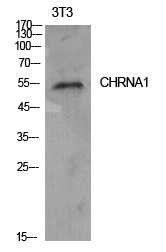产品名称
AChRα1 Rabbit Polyclonal Antibody
别名
CHRNA1; ACHRA; CHNRA; Acetylcholine receptor subunit alpha
蛋白名称
Acetylcholine receptor subunit alpha
存储缓冲液
Liquid in PBS containing 50% glycerol, 0.5% BSA and 0.02% New type preservative N.
Human Gene Link
http://www.ncbi.nlm.nih.gov/sites/entrez?db=gene&term=1134
Human Swissprot No.
P02708
Human Swissprot Link
http://www.uniprot.org/uniprotkb/P02708/entry
Mouse Gene Link
http://www.ncbi.nlm.nih.gov/sites/entrez?db=gene&term=11435
Mouse Swissprot No.
P04756
Mouse Swissprot Link
http://www.uniprot.org/uniprot/P04756
Rat Gene Link
http://www.ncbi.nlm.nih.gov/sites/entrez?db=gene&term=79557
Rat Swissprot Link
http://www.uniprot.org/uniprot/P25108
免疫原
The antiserum was produced against synthesized peptide derived from the Internal region of human CHRNA1. AA range:171-220
特异性
AChRα1 Polyclonal Antibody detects endogenous levels of AChRα1 protein.
稀释度
WB 1:500 - 1:2000. ELISA: 1:5000. IF 1:100-300 Not yet tested in other applications.
宿主
Polyclonal, Rabbit,IgG
背景介绍
The muscle acetylcholine receptor consiststs of 5 subunits of 4 different types: 2 alpha subunits and 1 each of the beta, gamma, and delta subunits. This gene encodes an alpha subunit that plays a role in acetlycholine binding/channel gating. Alternatively spliced transcript variants encoding different isoforms have been identified. [provided by RefSeq, Nov 2012],
组织表达
Isoform 1 is only expressed in skeletal muscle. Isoform 2 is constitutively expressed in skeletal muscle, brain, heart, kidney, liver, lung and thymus.
细胞定位
Cell junction, synapse, postsynaptic cell membrane ; Multi-pass membrane protein . Cell membrane ; Multi-pass membrane protein .
功能
disease:Defects in CHRNA1 are a cause of congenital myasthenic syndrome fast-channel type (FCCMS) [MIM:608930]. FCCMS is a congenital myasthenic syndrome characterized by kinetic abnormalities of the AChR. In most cases, FCCMS is due to mutations that decrease activity of the AChR by slowing the rate of opening of the receptor channel, speeding the rate of closure of the channel, or decreasing the number of openings of the channel during ACh occupancy. The result is failure to achieve threshold depolarization of the endplate and consequent failure to fire an action potential.,disease:Defects in CHRNA1 are a cause of congenital myasthenic syndrome slow-channel type (SCCMS) [MIM:601462]. SCCMS is the most common congenital myasthenic syndrome. Congenital myasthenic syndromes are characterized by muscle weakness affecting the axial and limb muscles (with hypotonia in early-onset forms), the ocular muscles (leading to ptosis and ophthalmoplegia), and the facial and bulbar musculature (affecting sucking and swallowing, and leading to dysphonia). The symptoms fluctuate and worsen with physical effort. SCCMS is caused by kinetic abnormalities of the AChR, resulting in prolonged endplate currents and prolonged AChR channel opening episodes.,disease:Defects in CHRNA1 are a cause of lethal type multiple pterygium syndrome [MIM:253290]. Multiple pterygia are found infrequently in children with arthrogryposis and in fetuses with fetal akinesia syndrome. In lethal multiple pterygium syndrome there is intrauterine growth retardation, multiple pterygia, and flexion contractures causing severe arthrogryposis and fetal akinesia. Subcutaneous edema can be severe, causing fetal hydrops with cystic hygroma and lung hypoplasia. Oligohydramnios and facial anomalies are frequent.,disease:The alpha subunit is the main focus for antibody binding in myasthenia gravis [MIM:254200]. Myasthenia gravis is characterized by sporadic muscular fatigability and weakness, occurring chiefly in muscles innervated by cranial nerves, and characteristically improved by cholinesterase-inhibiting drugs.,function:After binding acetylcholine, the AChR responds by an extensive change in conformation that affects all subunits and leads to opening of an ion-conducting channel across the plasma membrane.,similarity:Belongs to the ligand-gated ionic channel (TC 1.A.9) family.,subunit:Pentamer of two alpha chains, and one each of the beta, delta, and gamma (in immature muscle) or epsilon (in mature muscle) chains.,tissue specificity:Isoform 1 is only expressed in skeletal muscle whereas isoform 2 is constitutively expressed in skeletal muscle, brain, heart, kidney, liver, lung and thymus.,
纯化
The antibody was affinity-purified from rabbit antiserum by affinity-chromatography using epitope-specific immunogen.

